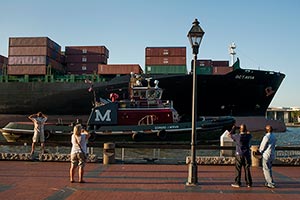Georgia, South Carolina Ready to Take Steps Toward Joint Port

Georgia and South Carolina are ready to start spending to build the $5 billion Jasper Ocean Terminal planned for a scrubby patch of South Carolina dirt and sand 15 miles below downtown Savannah.
The Georgia Ports Authority is expected to dedicate $7.5 million May 23 for environmental studies for the hoped-for port that wouldn’t open for at least a decade. South Carolina legislators already have ponied up their share. In three years, the states will need to kick in an additional $50 million to $100 million each for engineering, design and further environmental work.
Taxpayers already are spending about $1 billion deepening harbors and upgrading terminals and roads at the ports of Savannah and Charleston. The construction and maintenance price tag for all three ports could top $9 billion over the next 15 years, though not all costs would be borne by taxpayers.
Thousands of new jobs and billions in potential revenue are projected for the 1,500-acre port that would revolutionize a sleepy corner of South Carolina low country. Yet critics question whether any additional taxpayer money should be spent on a from-scratch port dependent upon an unpredictable global economy, especially if Jasper steals business from upriver Savannah.
“Are these projects in the ports’ and states’ interests? Probably. Are they in the federal interest? Absolutely not,” said Steve Ellis, vice president of Taxpayers for Common Sense in Washington. “The federal government looks at these ports in isolation when, in reality, all these ports, like it or not, will be in competition with one another. Sure, everybody’s making nice right now, but as we’ve seen before, there’ll be conflict between South Carolina and Georgia over the port of Jasper.”
Georgia’s ports account for an estimated $40 billion in statewide economic impact and tens of thousands of jobs, according to a University of Georgia study. Metro Atlanta, a distribution hub with huge truck and rail traffic, reaps about 70% of the economic benefit.
Savannah’s Garden City Terminal is projected to nearly run out of room in 15 years. Jimmy Allgood, the vice chairman of the Georgia Ports Authority, said now is the time to plan for, and begin paying for, a new port.
“We don’t know exactly what’s coming, but we do know there’ll be bigger ships and we’ll need more capacity,” said Allgood, who also is chairman of the bistate port project. “It’ll put thousands of people to work and add billions of dollars of tax revenue. It could really be a huge engine driving the South Carolina and Georgia economies.”
Ports along the Eastern seaboard are in a building frenzy in anticipation of a surge in big containerships delivering steel containers from Asia to U.S. consumers. A widened Panama Canal is due to open next month, allowing ships carrying as many as 14,000 containers a quicker route from China to the East Coast.
The U.S. Army Corps of Engineers is in the midst of a $706 million project to deepen 41 miles of the Savannah River. Georgia taxpayers have contributed $266 million; Congress is supposed to cover the rest.
Charleston, long a bitter competitor with Savannah for Southeastern U.S. port supremacy (Savannah handles 50% more containers annually), is planning a $509 million deepening project. Taxpayers already have contributed $300 million.
Well before either project is completed, though, the states have committed to build an estimated $4.3 billion terminal with docks, warehouses and roads along the Savannah River. Deepening and widening, again, a 21-mile stretch of the Savannah River into the Atlantic Ocean could cost an additional $1.5 billion, depending on how deep Jasper backers want to go.
So far, the states have contributed $10 million on preliminary plans. The next installment — $7.5 million each — goes for an environmental impact study with public hearings scheduled this fall.
Within three years, though, each state must come up with $50 million to $100 million more for engineering and design work. It’s unclear where that money will come from. The Georgia Ports Authority, with a projected $343 million in revenue this upcoming fiscal year, could readily pay its share without taxpayer help. South Carolina, which pulls in about $210 million annually, might have a harder time.

